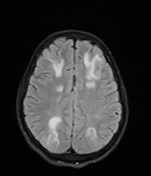Search results for “MELAS”
29 results found
Article
Mitochondrial encephalomyopathy with lactic acidosis and stroke-like episodes (MELAS)
Mitochondrial encephalomyopathy with lactic acidosis and stroke-like episodes (MELAS) is one of many mitochondrial disorders. As mitochondria, which have their own DNA, are exclusively passed on from the mother these disorders are only maternally inherited.
On imaging, it manifests as multifoca...
Case
MELAS

Published
26 Apr 2010
71% complete
MRI
Case
Mitochondrial encephalomyopathy with lactic acidosis and stroke-like episodes (MELAS)

Published
12 Jan 2023
95% complete
CT
MRI
Case
Mitochondrial encephalomyopathy, lactic acidosis, and stroke-like episode (MELAS)

Published
14 Jun 2020
75% complete
MRI
CT
Case
Mitochondrial encephalomyopathy, lactic acidosis, and stroke-like episodes (MELAS)

Published
11 Jan 2012
70% complete
CT
MRI
Case
Mitochondrial encephalomyopathy, lactic acidosis, and stroke-like episode (MELAS)

Published
12 Sep 2019
68% complete
MRI
Article
Black toenail sign
The black toenail sign is a radiological sign described in mitochondrial encephalomyopathy with lactic acidosis and stroke-like episodes (MELAS) on MRI.
The sign describes the subacute appearance of radiological correlates of stroke-like episodes, whereby there are small regions of deep cortica...
Article
Primary mitochondrial disorders
Primary mitochondrial disorders (PMDs) are a clinically heterogeneous group of conditions caused by pathologic variants in mitochondrial DNA (mtDNA) or nuclear DNA (nDNA).
There are many conditions that result from mitochondrial dysfunction affect the neurological and muscular systems in a vari...
Article
Myoclonic epilepsy with red ragged fibers (MERRF)
Myoclonic epilepsy with red ragged fibers (MERRF) is a rare multisystem mitochondrial disorder.
Clinical presentation
Patients usually present in late adolescence or early adulthood with 1-3
myoclonus
epilepsy
cerebellar ataxia
intellectual disability
vision and/or hearing loss
cardiomyo...
Article
Cerebral autosomal dominant arteriopathy with subcortical infarcts and leukoencephalopathy (CADASIL)
Cerebral autosomal dominant arteriopathy with subcortical infarcts and leukoencephalopathy (CADASIL) is an autosomal dominant microvasculopathy characterized by recurrent lacunar and subcortical white matter ischemic strokes and vascular dementia in young and middle age patients without known va...
Article
Basal ganglia calcification
Basal ganglia calcification is common and is seen in approximately 1% of all CT scans of the brain, depending on the demographics of the scanned population. It is seen more frequently in older patients and is considered a normal incidental and idiopathic finding in an elderly patient but should ...
Article
Leukodystrophies
The leukodystrophies are a heterogeneous group of disorders that primarily affect the white matter of the central nervous system. They are particularly encountered in childhood as many are genetically determined and represent abnormalities in white matter metabolism. A number of leukodystrophies...
Article
Cerebral small vessel disease
Cerebral small vessel disease, also known as cerebral microangiopathy, is an umbrella term for lesions in the brain attributed to pathology of small arteries, arterioles, capillaries, venules, or small veins. It is the most common cause of vascular dementia/cognitive impairment and is a major ca...
Article
Anton-Babinski syndrome
Anton-Babinski syndrome, also known as Anton syndrome, is a type of cortical blindness occurring as a result of bilateral occipital lobe lesion. The syndrome consists of blindness, visual anosognosia and confabulation 1-5.
Epidemiology
The syndrome is rare with 28 documented cases between 196...
Article
Bilateral temporal lobe T2 hyperintensity
Bilateral temporal lobe T2 hyperintensity refers to hyperintense signal involving the temporal lobes on T2 weighted and FLAIR imaging. It is a common finding on brain MRI and a wide range of differentials should be considered 1.
Causes include:
neurodegenerative disease
frontotemporal dementi...
Article
Cerebellar restricted diffusion
Cerebellar restricted diffusion refers to a hyperintense signal involving the cerebellum on DWI images with a corresponding low signal on ADC images.
Vascular thrombo-occlusive disease
cerebellar arterial infarction 1
AICA infarction
PICA infarction
superior cerebellar arterial infarct
ce...
Article
Stroke in children and young adults
Stroke in children and young adults can result from several causes, which are distinct from the most common causes in adults.
Pathology
Etiology
Arterial ischemic stroke
arteriopathies
CADASIL (cerebral autosomal dominant arteriopathy with subcortical infarcts and leukoencephalopathy)
CARA...
Article
Cerebral cortical restricted diffusion
Cerebral cortical restricted diffusion, also known as gyriform restricted diffusion, cortical ribboning or cortical ribbon sign, refers to curvilinear hyperintense signal involving the cerebral cortex on DWI images with a corresponding low signal on ADC images.
Causes include the following diso...
Article
COL4A1 brain small-vessel disease
COL4A1 brain small-vessel disease is an autosomal dominant monogenic COL4A1-related disorder that primarily causes cerebral small vessel disease.
Epidemiology
The exact prevalence is unknown, but the condition is likely under-diagnosed.
Clinical presentation
The clinical presentation is vari...
Article
Central nervous system curriculum
The central nervous system curriculum is one of our curriculum articles and aims to be a collection of articles that represent the core central nervous system knowledge.
Definition
Topics pertaining to the intracranial content (brain, pituitary, dura, intracranial vasculatures). There will be...









 Unable to process the form. Check for errors and try again.
Unable to process the form. Check for errors and try again.